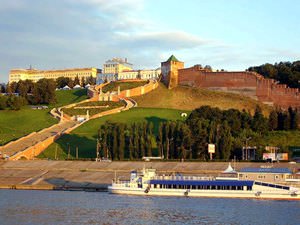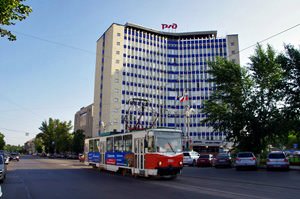 Nizhny Novgorod was founded upon the order of Vladimir Duke Yuri Vsevodolovich in 1221. The city had long been an important defense point of the Russian land. Throughout its history, it was renamed twice. Its first name, Nizhny Novgorod, is still relevant. From 1932 to 1990, it was named Gorky after the Soviet writer Maxim Gorky. In 2000, Nizhny Novgorod became a capital of the Volga Federal District.
Nizhny Novgorod was founded upon the order of Vladimir Duke Yuri Vsevodolovich in 1221. The city had long been an important defense point of the Russian land. Throughout its history, it was renamed twice. Its first name, Nizhny Novgorod, is still relevant. From 1932 to 1990, it was named Gorky after the Soviet writer Maxim Gorky. In 2000, Nizhny Novgorod became a capital of the Volga Federal District.
In the middle of the 12th century, a small Slavic fortified settlement was formed on the territory of the modern city at the mouth of the Oka River. It was called the Old Town. In the period between 1228 and 1239, the white stone Cathedral of Archangel Michael and Cathedral of the Transfiguration of the Savior were built here, followed by the building of the cathedrals of the Grand Duchy of Vladimir.
Today, the city with a rich and eventful history is one of the most attractive cities of the country from a tourist point of view. Its amazing history is reflected in unique architectural monuments. Local museums present interesting collections concerning different periods of the city development. Nizhny Novgorod is perfect for walking, excursion tourism, and the acquaintance with the original Russian culture. With it, it is a beautiful modern city that will delight its guests with comfortable entertainment venues and a well-developed infrastructure.
 The main historical symbol of the city is the Nizhny Novgorod Kremlin. This impregnable fort was built in the 16th century. Originally, it was a large complex but only 13 towers and the 5-meter wall, which length is over 2km, have been preserved to this day. Beyond the fort, there are historical constructions built in different period. Today, most of the historical buildings are occupied by the representatives of regional and city government. Tourists are more interested in the Kremlin towers that house different exhibits.
The main historical symbol of the city is the Nizhny Novgorod Kremlin. This impregnable fort was built in the 16th century. Originally, it was a large complex but only 13 towers and the 5-meter wall, which length is over 2km, have been preserved to this day. Beyond the fort, there are historical constructions built in different period. Today, most of the historical buildings are occupied by the representatives of regional and city government. Tourists are more interested in the Kremlin towers that house different exhibits.
One of the most picturesque places in the city is the Fedorovsky embankment located on the Oka bank. It has a spectacular view of the river and many famous attractions. The embankment is an excellent viewing platform where you can admire Stroganov Church, the Kanavino Bridge, and other interesting constructions. In the warm period, the embankment is always decorated with interesting landscape attractions.
 Stroganov Church is a beautiful religious monument in Nizhny Novgorod. It is called after famous industrialist Grigory Stroganov who lived here in the late 19th century. This fascinating church was built at his expense. It was distinguished by its incredible beautiful exterior and interior. It is one of the few religious monuments in the city that was not destroyed at the time of the USSR. The main peculiarity of the temple is colorful domes. Its historical facade has also been preserved in its original form.
Stroganov Church is a beautiful religious monument in Nizhny Novgorod. It is called after famous industrialist Grigory Stroganov who lived here in the late 19th century. This fascinating church was built at his expense. It was distinguished by its incredible beautiful exterior and interior. It is one of the few religious monuments in the city that was not destroyed at the time of the USSR. The main peculiarity of the temple is colorful domes. Its historical facade has also been preserved in its original form.
Another unique architectural monument is the Main Fair House located in the city center. At one time, the greatest fair in the Russian Empire was held in this luxurious building with rich interior. In 1816, the building was significantly damaged in a fire but then was restored fast. Nowadays, different cultural events are held in this fascinating building. There is a big square with landscape decorations in front of it.
 The House of Peter the Great is a symbolic attraction of the city. This is a small stone mansion that was built in the 17th century and belonged to the rich merchant. According to some data, Peter I repeatedly stayed here. Since the 19th century, the historical building serves as a small museum.
The House of Peter the Great is a symbolic attraction of the city. This is a small stone mansion that was built in the 17th century and belonged to the rich merchant. According to some data, Peter I repeatedly stayed here. Since the 19th century, the historical building serves as a small museum.



